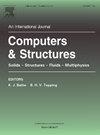非圆孔功能梯度板应力集中优化
IF 4.8
2区 工程技术
Q1 COMPUTER SCIENCE, INTERDISCIPLINARY APPLICATIONS
引用次数: 0
摘要
本文考虑了在单轴牵引作用下功能梯度无限板的非圆孔和切口应力集中的最小化问题。在对材料变化类型进行合理假设的情况下,通过数值计算解决了在不确定杨氏模量函数形式的前提下,确定整个板的最佳杨氏模量分布的优化问题。求解技术涉及将等参有限元方法嵌入到约束非线性规划问题的顺序二次规划算法中。受最近一项关于带圆孔的无限板的研究结果的启发,这项工作提出了对更广泛的几何不连续类的最佳裁剪方法的非平凡推广。考虑了椭圆孔、端部为半圆的矩形槽和端部为相对半圆的圆孔三种实际情况,杨氏模量分布的数值最优解导致弹性性能优于均匀和常用的前缀级配律。相关的应力行为以图形形式显示在不同的刚度比的成分,讨论和比较均匀板。本文章由计算机程序翻译,如有差异,请以英文原文为准。
Stress concentration optimization for functionally graded plates with noncircular holes
In this paper, the minimization of the stress concentration due to noncircular holes and cutouts in functionally graded infinite plates subjected to uni-axial traction is considered. Under reasonable assumptions regarding the type of material variation, an optimization problem aimed at determining the best Young’s modulus distribution throughout the plate without prefixing its functional form is numerically solved. The solution technique involves embedding the isoparametric finite element method within a sequential quadratic programming algorithm for constrained nonlinear programming problems. Motivated by results of a recent study concerning infinite plates with a circular hole, this work presents a non-trivial generalization of the best tailoring approach for a broader class of geometrical discontinuities. Three practical examples such as elliptic holes, rectangular slots with semicircular ends and circular holes with opposite semicircular lobes are considered and numerical optimal solutions for the Young’s modulus distribution lead to elastic performance that outperforms the homogeneous and commonly employed prefixed gradation laws. The associated stress behavior is shown in graphical form for different stiffness ratios of the constituents, discussed and compared to the homogeneous plates.
求助全文
通过发布文献求助,成功后即可免费获取论文全文。
去求助
来源期刊

Computers & Structures
工程技术-工程:土木
CiteScore
8.80
自引率
6.40%
发文量
122
审稿时长
33 days
期刊介绍:
Computers & Structures publishes advances in the development and use of computational methods for the solution of problems in engineering and the sciences. The range of appropriate contributions is wide, and includes papers on establishing appropriate mathematical models and their numerical solution in all areas of mechanics. The journal also includes articles that present a substantial review of a field in the topics of the journal.
 求助内容:
求助内容: 应助结果提醒方式:
应助结果提醒方式:


